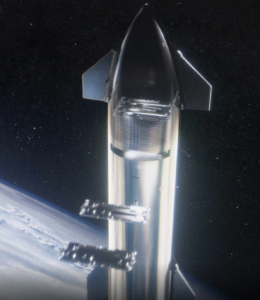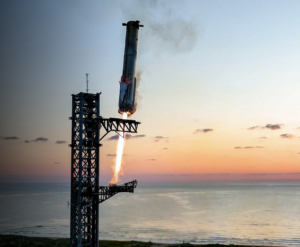Key points:
- One key goal of SpaceX’s ninth Starship test flight on May 27th was to try once again to test the innovative "Pez Dispenser" satellite deployment system, which will be used to launch the upcoming Starlink V3 satellites.
- The cargo hatch on Starship failed to open when commanded - trapping the Starlink V3 satellite simulators inside.
- Though it reached orbital velocity successfully (unlike the prior two tests) - Starship sprung a leak and tumbled towards an uncontrolled re-entry before most other test flight objectives could be completed.
- This third major testing failure in a row is a major setback for the SpaceX Starship program, and will likely delay the next generation of Starlink satellites coming online.

SpaceX's Starship development program is having a bad year - yesterday experiencing its third major failure in a row.
Yet another “Rapid Unscheduled Disassembly” without meeting key test objectives is a major embarrassment for SpaceX - and this stumble will potentially slow down the development of the massively upgraded Starlink V3 satellites.
The test flight was not a complete failure - flight nine did reach orbital velocity, unlike flights seven in January and eight in March which both blew up spectacularly over the Caribbean.
And this was the first time SpaceX tried to reuse a Super Heavy booster - successfully re-flying the booster that was used in the January tests.
But pretty much everything else went wrong.
The booster was intended to be discarded in the Gulf after testing some new landing maneuvers - but it unexpectedly blew up before the final simulated landing burn could be completed.
And the Starship failed to even begin testing the Starlink deployment system when the cargo hatch refused to open.
Shortly thereafter - SpaceX lost control of Starship, and it tumbled out of control into the Indian Ocean.
It was not a happy day for SpaceX.
After three failures in a row - will SpaceX need to take some time for a more major redesign?
Or will they push ahead and try the same basic design and tests once again, as soon as next month?
Table of Contents
Starship’s “Pez Dispenser” Deployment System Jams
One key goal of Starship's seventh, eighth, and ninth test flights was to showcase a new way to deploy satellites - via a "Pez Dispenser" deployment mechanism that would take a stack of up to 54 Starlink V3 satellites - spitting them out one at a time via a hatch on the side.
SpaceX had successfully tested the hatch mechanism back on test flight 3 in March 2024, the first Starship to reach orbital velocity.
But yesterday - when SpaceX commanded Starship to “open the pod bay doors”, the reply was “I’m sorry, I can not do that.”
The hatch was jammed - and for the third flight in a row the Pez Dispenser and stack of dummy Starlink V3 satellites remained untested.
Needless to say - SpaceX needs to perfect this system before it can begin deploying functional Starlink V3 satellites.
Starlink V3 - An “Insane” Upgrade
SpaceX has shared a few details of the Starlink V3 satellite capabilities. On yesterday’s livestream, they called it an “insane” increase over the current Starlink V2 Mini design.
The V3 satellites are physically larger (approximately 1900 kg vs. 575 kg), and thus have more solar and computing power available.
Comparing the individual V3 satellites with the V2 Mini - SpaceX has said that each V3 Starlink satellite will have 1 Tbps of total user downlink capacity and 160 Gbps of uplink capacity.
Compared to the current V2 Mini, which was already a 4x upgrade over the first generation of Starlink satellites:
- Total User Downlink Bandwidth: 1 Tbps vs 96 Gbps
- Total User Uplink Bandwidth: 160 Gbps vs 6.7 Gbps
- Ground Station & Laser Interconnect Bandwidth: 4 Tbps vs 1.3 Tbps
Overall - this is 10x the downlink and 24x the uplink capacity of the V2 Mini Starlink satellites.
The V3 satellites are the key to Starlink’s long term evolution - and they are stuck waiting for their ride to space.
Concluding Thoughts

Unlike NASA - SpaceX operates on a “failure is an option” development cycle, iterating rapidly to learn from and move past discovered issues.
But THREE major failures in a row is extremely unusual for SpaceX.
The primary goal of these past few flights had been to test new systems to move towards being ready for orbital missions and deploying Starlink satellites, while development continued on perfecting the re-entry heatsshield to allow for rapid reuse.
But it is concerning that SpaceX has been failing in phases of flight that it seemingly had perfected before - and most of the new test objectives have not been met at all during flights so far in 2025.
At one point SpaceX had hoped for as many as 25 Starship flights this year - that goal is looking impossible now.
But hopefully SpaceX will soon get things back on track - and maybe we will see Starlink V3 ready to fly by the end of the year after all.
Learn More:
Starlink's Referral FAQ.
Use our referral link when purchasing equipment from Starlink.com and activating a consumer Residential or Roam Unlimited data plan - and get a FREE month of service!
And so will someone on our team, which helps us keep our multiple lines of service active for continued testing.
It's a win-win - you save money and help support MIRC!
Further Reading
- Starlink Satellite Internet For Mobile RV And Boat Use - Our featured guide focused on taking advantage of SpaceX's Starlink on the go.
- Mobile Satellite Internet Options -
 Our featured guide on all the current and future satellite internet options of interest to RVers and cruisers.
Our featured guide on all the current and future satellite internet options of interest to RVers and cruisers. - All our our Satellite Internet Resources - Our collection of guides, gear center entries and news coverage on satellite internet.
- Industry Update: 2025 Satellite Mobile Internet Update: Starlink, Kuiper, Direct To Cellular, and More! - Our deep dive into the state of the satellite internet world.
And here is all of our recent satellite internet coverage:









 Mobile Internet Resource Center (dba Two Steps Beyond LLC) is founded by Chris & Cherie of
Mobile Internet Resource Center (dba Two Steps Beyond LLC) is founded by Chris & Cherie of